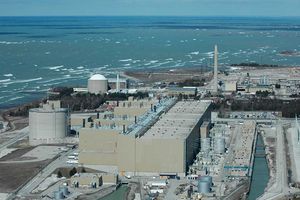Pressurized heavy water reactor

A pressurized heavy water reactor is a type of nuclear reactor that makes use of heavy water () as its coolant and moderator. Heavy water contains an isotope of hydrogen called deuterium. Deuterium absorbs fewer neutrons than hydrogen, which is extremely important as nuclear fission reactions require neutrons to carry out their chain reactions.[2] The heavy water is kept under pressure which increases its boiling point so that it can operate at high temperatures without boiling.
Heavy water is rare, and extracting it from ordinary water is expensive. Although it comes at an increased price, it doesn't require the uranium fuel to be enriched like in some other nuclear reactors. This greatly decreases the expense for the heavy water because uranium enrichment requires separate facilities and extensive processes.
The CANDU reactor is the first and most widely used heavy water reactor, with over 20 in commission in Canada and around the world in Romania, India, China, Pakistan, South Korea and Argentina.[3][4]
Visit the CANDU page for more details on heavy water nuclear reactors.
References
- ↑ Wikimedia Commons [Online], Available: http://en.wikipedia.org/wiki/CANDU_reactor#/media/File:Bruce-Nuclear-Szmurlo.jpg
- ↑ R. Wolfson, "Nuclear fission" in Energy, Environment, and Climate, 2nd ed., New York, NY: W.W. Norton & Company, 2012, ch. 7, sec. 4, pp.173
- ↑ B. Everett, G. Boyle, S. Peake and J. Ramage, "Nuclear power" in Energy Systems and Sustainability, 2nd ed., Oxford, UK: Oxford, 2013, ch.10, pp.407-414
- ↑ http://www.candu.org/candu_reactors.html online, accessed July 5th, 2015.

